21 August 2020
An Antelope or a Deer?
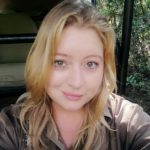
Hi everyone! Welcome back to another blog.
Common questions that pop up on a safari, when we see our first Antelope species on the reserve are; “Is it a deer?” or, “What’s the difference between an Antelope and a Deer?” Well, I’m hoping to shed some light on that for you today.
Antelope and Deer look almost exactly alike, and really, it comes down to a couple of technical differences that sets them apart from each other.
Antelope (usually the males) have horns, which are a permanent fixture to their head. The horns are in fact ‘living’ bone which is covered in thick layers of dead horn tissue. Depending on the species of Antelope, the shape of the horns varies widely, however, one of the things that they all have in common is that horns do not branch.
Deer (usually the males) have antlers, which they shed seasonally – normally at the end of every mating season. The antlers are made up of vascular spongy tissue, which is covered in a soft skin, called Velvet. As the antlers mature, the Velvet falls off, and the antlers become hard bone. Unlike the horns of an Antelope, the antlers of a Deer branch distinctively. Deer, as some of you may know, do not occur naturally in Africa.
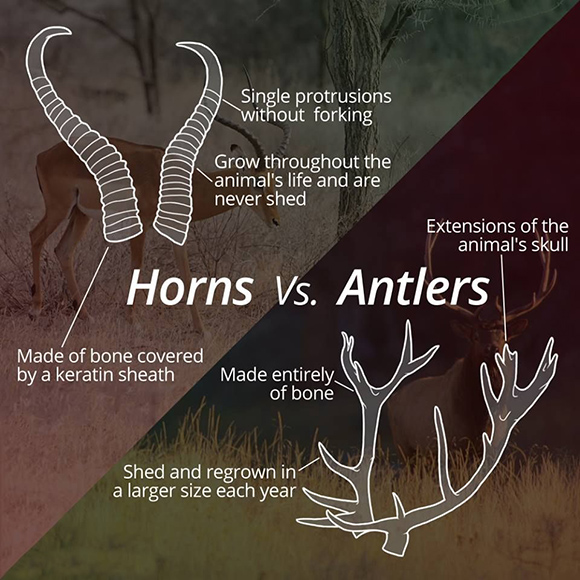
I’m going to give you just a little bit of scientific info (I promise to keep it short) and discuss some of the wonderful facts about the different species of Antelope that are found here at Inkwenkwezi.
All species of Antelope are classified as Ruminants, but what is a Ruminant?
Ruminants belong under the order Ruminantia which means that the animals found in this order stand on the tips of their third and fourth toes, which are covered by horny hooves. All members of this order are herbivorous (they feed on vegetation) and they all have a four-chambered stomach and ruminate (re-chew their food). They also have no upper incisor teeth.
At Inkwenkwezi we have Antelope of all shapes and sizes.
The largest Antelope species found at Inkwenkwezi is the Eland (Taurotragus oryx). These magnificent ox-like antelope are in fact the largest species of antelope in Southern Africa. With the males weighing over 900kg and standing with a shoulder height of up to 1.7m, they are a sight to behold, especially because they are so shy and quick to run off at the slightest disturbance. The males have a distinct mop of dark hair on the top of their head that the females do not have and both males and females have a large dewlap (a fold of loose skin) hanging from their lower neck. There are many theories about the purpose of a dewlap, two of the most popular being to attract mates or to help dispel excess body heat.
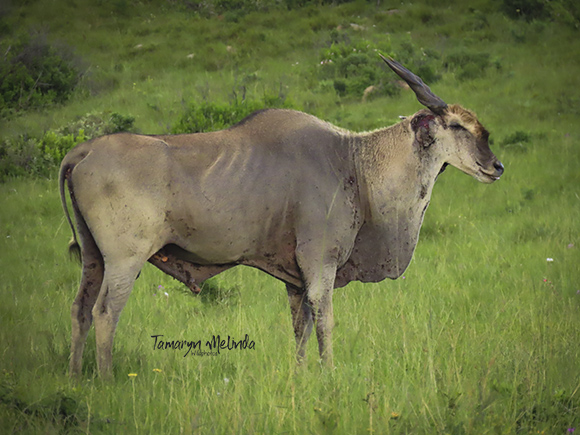
Large Dewlap 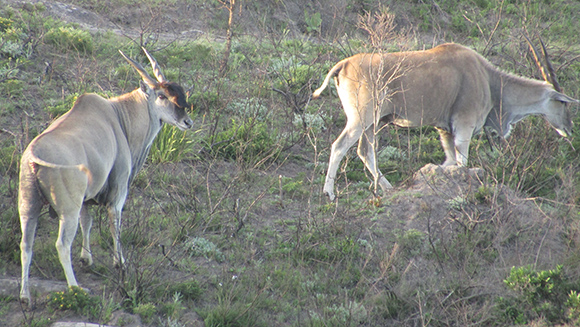
Mop of Dark Hair on a Beautiful Male
One of the most interesting things that you could experience if you ever manage to get close enough to an Eland is the distinct ‘clicking’ sound that you hear as they walk. There was much debate as to what caused this ‘clicking’ sound. One of the most popular theories was that the noise is made when their hooves click together – the two halves of hoof, that were once spread apart by the Eland’s incredible weight, snap together when the Eland lifts it leg and the weight is lifted causing the ‘clicking’ noise, however, recent studies have proven that it is in fact a tendon on their lower leg that makes the clicking noise as it snaps over the lower leg bones. The sound of the ‘clicking’ becomes more apparent with age which leads many to believe that this louder sound coming from the older bulls while walking, deters the younger bulls from challenging them to a fight.
Despite their enormous size Eland can run at speeds of up to 40km/h and are admirably adapted jumpers and can easily jump over a three-meter fence with a running start, which is phenomenal for their size.
Although Eland look very much like large cattle, they are predominantly browsers (feeding on trees and shrubs) breaking branches by twisting them between their horns or hooking their horns over them to reach fresh leaves, only turning to succulent green grass in the summer months.
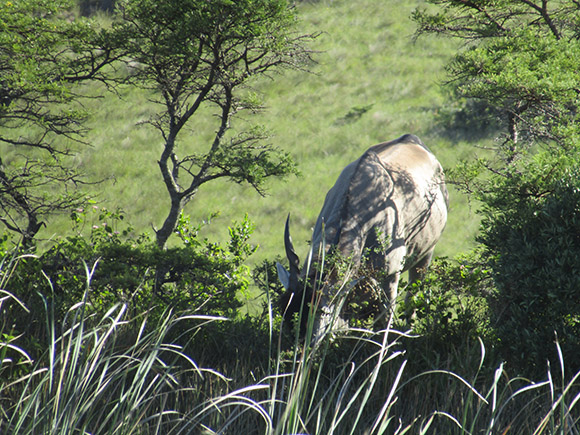
Eland Drinking 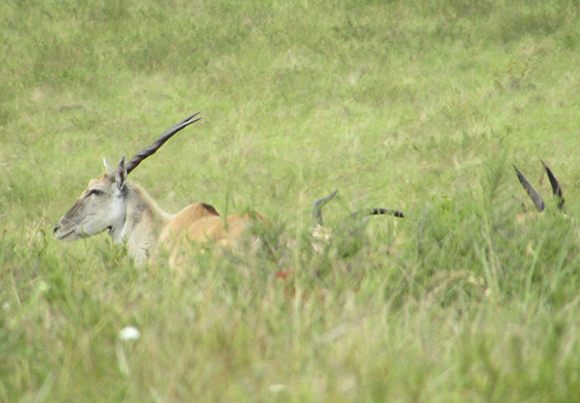
Eland resting in the long grass 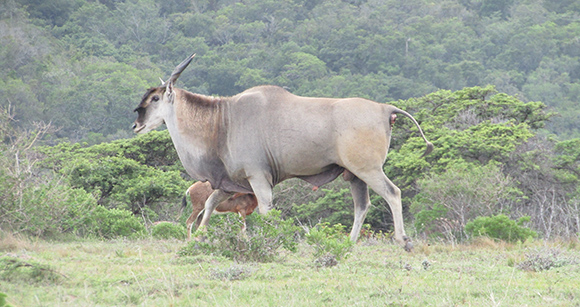
Can you see the Blesbok hidden behind his legs?
Kudu males fight ferociously. Their beautiful, long, spiraling horns become locked together and the males are unable to disengage from one another. Both end up helpless to the fangs and claws of any nearby predators and both are unable to feed or search for water.
This tragic sight is more common than not with Kudu bulls (Tragelaphus strepsiceros). A lesson to be learned by us all – always think of the consequences before blindly jumping headfirst into a fight – always remember the Kudu…!
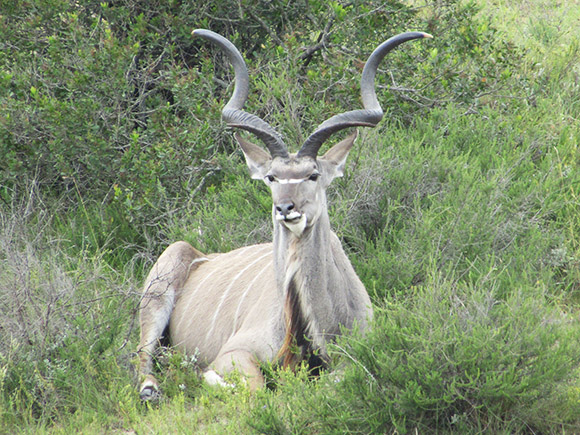
Being predominantly crepuscular (active at dawn and dusk), most sightings of Kudu will occur in the early hours of the morning and the late afternoon. The males have characteristic large, long spiralling horns that grow an average length of 120cm (two and a half turns) and both male and female have unusually large ears. The ears are quite red in colour on the inside, this is from the abundance of blood capillaries used largely to regulate body temperature.
There is no doubt that Kudu are one of the most majestic antelope that you could find out in the African bush, with a shoulder height of up to 1.4 meters and a weight between 190kg and 260kg. Generally most sightings of Kudu will occur in a semi-dense bushveld as Kudu like to stay hidden and are predominantly browsers, but they also don’t like the bush to be excessively dense, however, you do occasionally get beautiful Kudu sightings in the open grasslands eating fresh green grass.
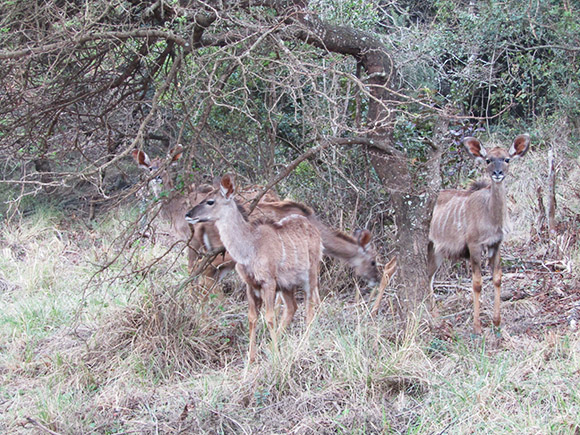
Young Kudu 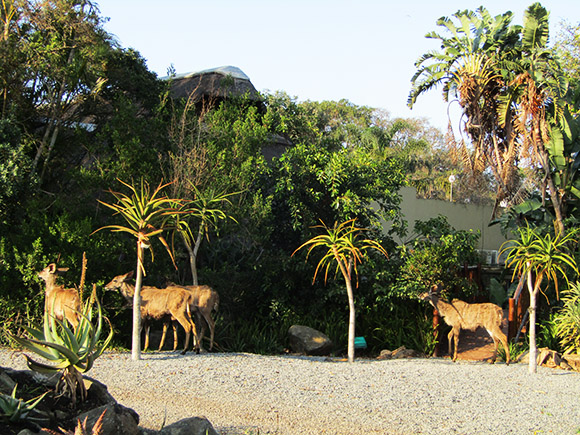
Kudu exploring Reception 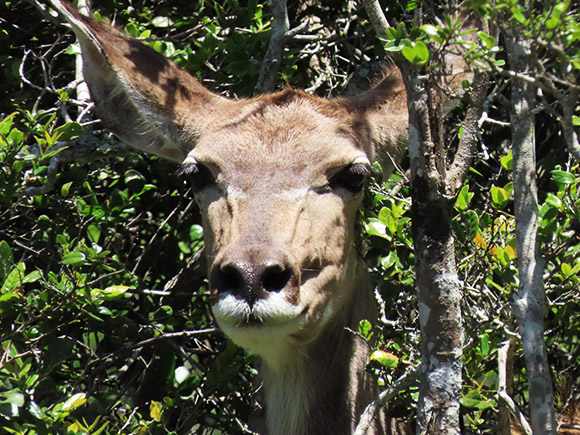
Female Kudu 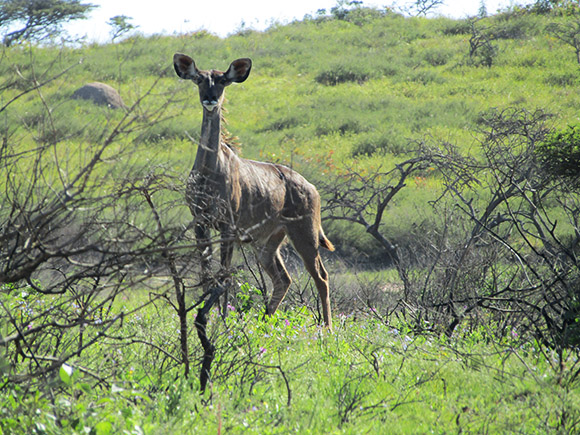
Female Kudu in the open grass plains. 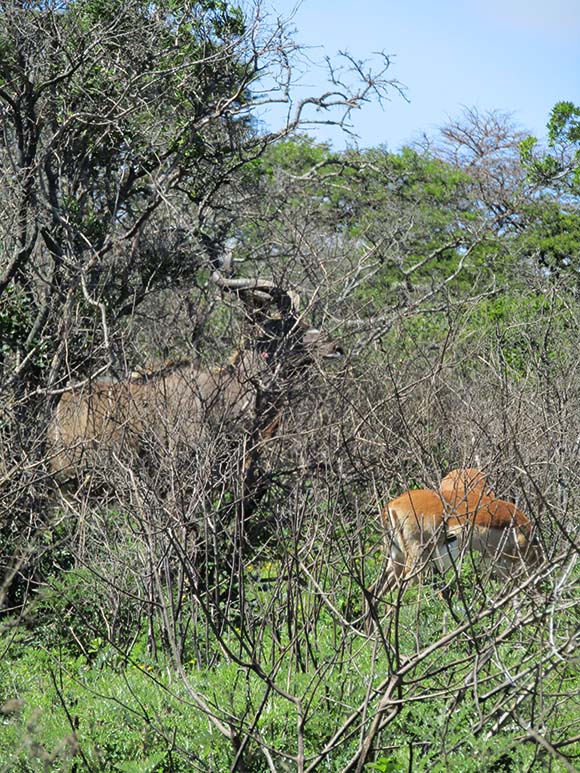
You can’t see me!
Similar in look to a Kudu, a Nyala (Tragelaphus angasii) is my favourite antelope species. With a gorgeous, multi-coloured, shaggy coat and what looks like neat tribal painting over their face, the males are the focal point for my camera whenever I come across sightings of Nyala.
Lowering their heads and arching their spines, lifting the long, white hair on their backs, puffing up their tails to almost four times the size and taking slow, deliberate steps, circling one another… Two male Nyala show off in a beautiful display for dominance, making the ladies hearts melt as they show off their size and beauty.
It’s an incredibly rare sight to see male Nyala clash horns in a fight for dominance as 90% of the time one of the males will back down in the dominance display.
Nyala are the species of antelope with the most sexual dimorphism (difference in appearance between male and female) than any other species of antelope. The males having a long, shaggy, dark grey coat, complimented by white trimmings, stripes and spots, with light, yellowish-brown socks on his legs and a beautiful set of spiral horns. Females on the other hand are much smaller, with short yellowish-brown fur with a couple of stripes and spots on her coat and no horns.
Something amazing (and sometimes confusing) is that when male Nyala are born, they look exactly like females, up until about two years of age, only then will they start to get their dark colouring, long fur and their horns will start to grow. This is the age when they are usually kicked out of the herd by the older and more dominant males. It is almost like the young males are in “disguise” for the first two years of their lives, incognito until they are old enough to be able to survive on their own and they are pushed out of the herd, making bachelor herds (groups of males) very common in this species.
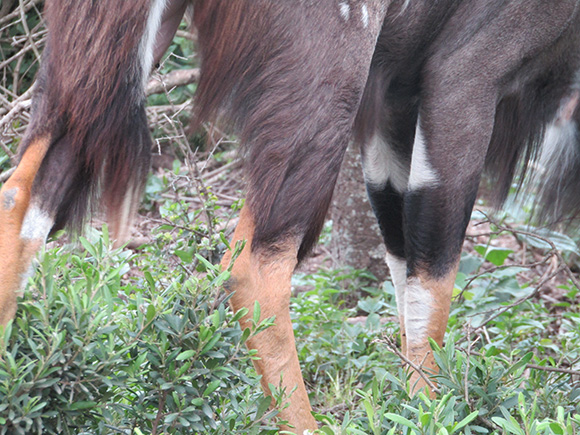
Shaggy coat and yellow legs 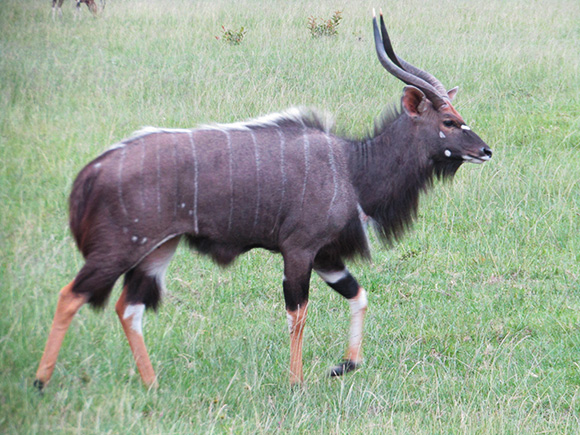
Male Nyala 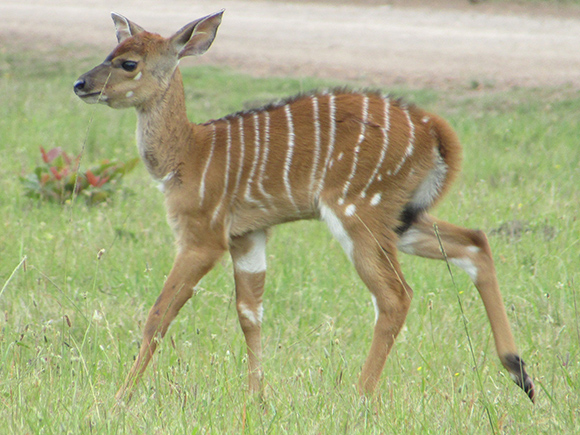
Nyala lamb 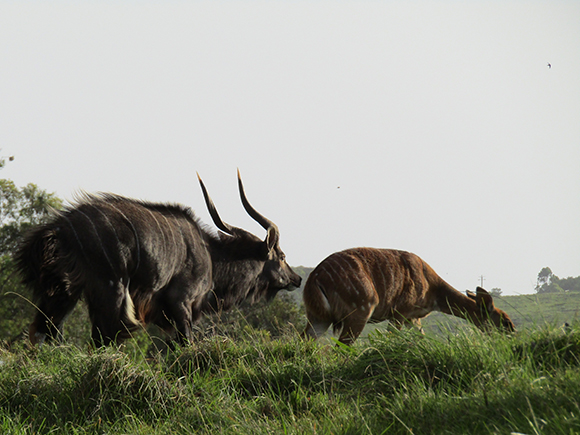
Male and female Nyala 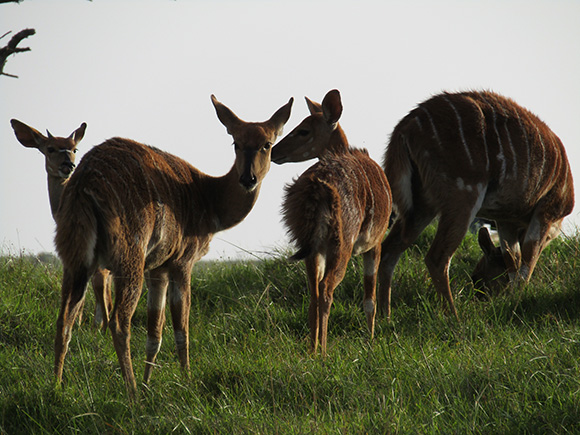
Note the young male Nyala on the far left.
Male Nyala can weigh up to 107kg with a shoulder height of up to 1.2 meters, whereas females only weigh up to 68kg with a shoulder height of up to 97 centimetres, giving you a good idea of just how different they are in size.
Being mixed feeders, it is possible to have sightings of Nyala in most areas of the reserve, however they are predominantly found in more dense vegetation, where they can easily hide.
Nyala are a ‘stepping-stone’, so to speak, regarding the male, female, and young terms:
- All male antelope smaller than Nyala males, are referred to as Rams
- Female Nyala and all female antelope smaller than them, are referred to as Ewes
- Nyala young and all antelope smaller than them, are referred to as Lambs
- Male Nyala and all male antelope larger than them, are referred to as Bulls
- Female antelope larger than Nyala, are referred to as Cows
- Antelope young larger than Nyala, are referred to as Calves
Silently walking through the thick bush, carefully stepping with his hind hooves exactly where the front hooves once were, almost invisible to the eye as the dappled shade dances around on his tawny coat.
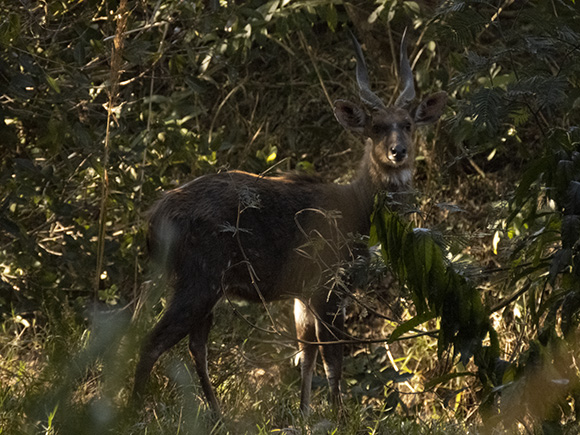
Bushbuck (Tragelaphus scriptus) are notoriously difficult to spot on safari as they are incredibly shy, secretive and blend in remarkably well to their surroundings. As their name suggests, Bushbuck prefer to reside in dense bush, relying on their silent movements and camouflage to stay hidden. With a tawny brown coat (males darker than females) Bushbuck have many spots scattered across their fur, simulating the dappled shade in the dense bush of forested areas. Usually sightings will be quick, with a split second of eye contact before the Bushbuck dashes off in the opposite direction to hide again.
With a shoulder height of up to 79 centimetres and a weight of up to 54kg, Bushbuck are marginally smaller than the previous antelope species that I have mentioned.
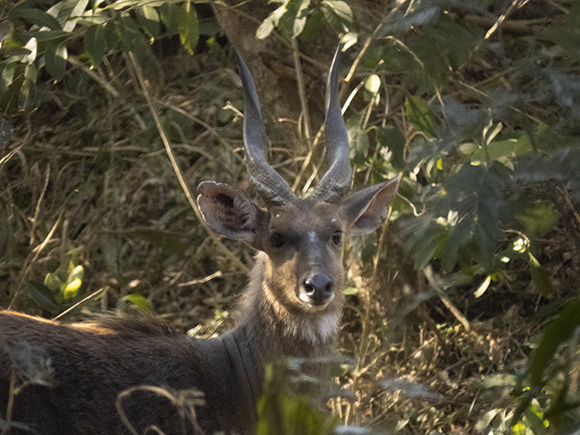
Male Bushbuck 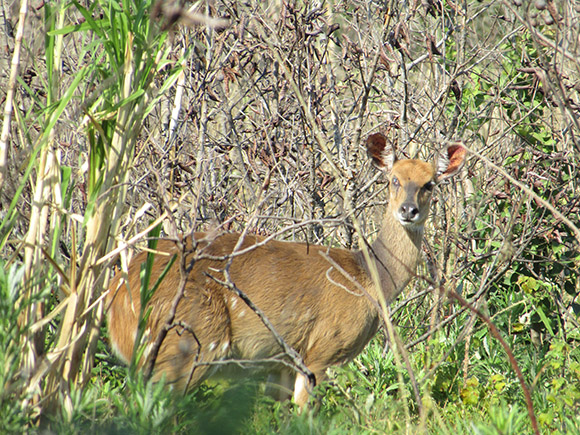
Female Bushbuck
Kudu, Nyala and Bushbuck are easily confused with regards to identification, especially with the males as all three of these antelope are members of the Tragelaphus family of spiral horned antelope and all look remarkably similar.
The easiest way to differentiate the three is to remember the following identifying features on their coats:
- Kudu have stripes only
- Nyala have stripes and spots
- Bushbuck have spots only
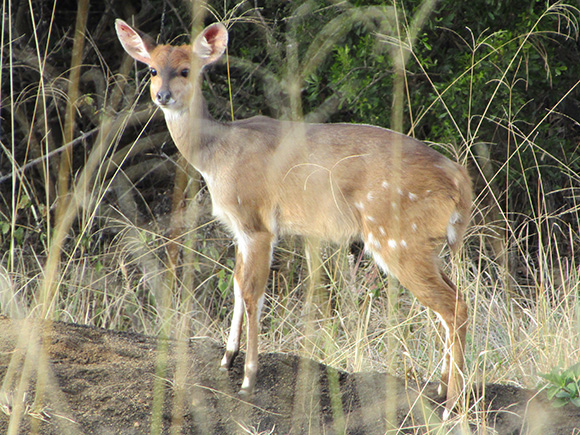
Bushbuck Spots 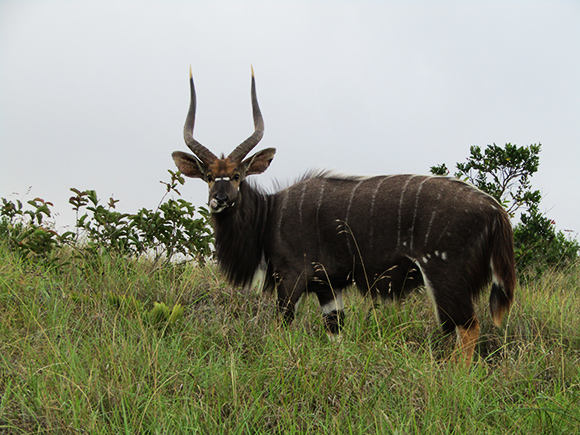
Nyala Stripes and Spots 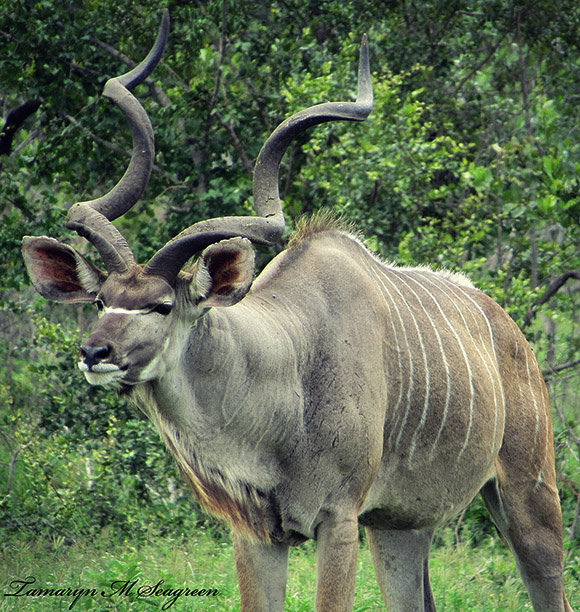
Kudu Stripes
Did you know that Wildebeest are in fact an Antelope as well? Here on Inkwenkwezi we have Blue Wildebeest (Connochaetes taurinus). An odd name I know, they are also known as ‘Brindled Gnu’, which refers to their brindled colour and the sound they make.
Their strange appearance is said to be a result of being the last animal created by God. With the large head of a Buffalo, the strange slanted back of a Spotted Hyaena, the thin, brown legs of an Antelope and the long tail of a Horse, many believe them to be a bad omen, casting bad luck on any that try to hunt them.
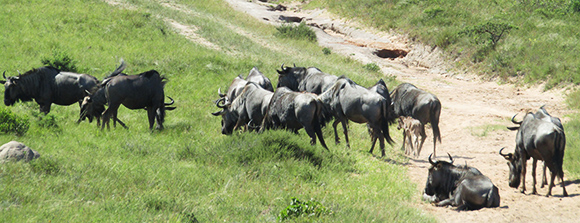
Despite their strange appearance, Blue Wildebeest are admirably adapted for surviving in the African bush, their long, well-built front legs carry the weight of their large head so well that it enables them to run vast distances without getting tired. Their long tails make impressive flyswatters and their brindled colour helps to regulate their body temperature keeping them cool in the hot sun.
With a shoulder height of up to 1.4 meters and an average weight of up to 250kg the Blue Wildebeest is one of the larger species of antelope that you will find roaming the open plains. Being predominantly grazers, preferring short grass to feed on, it’s rare to find them in dense vegetation.
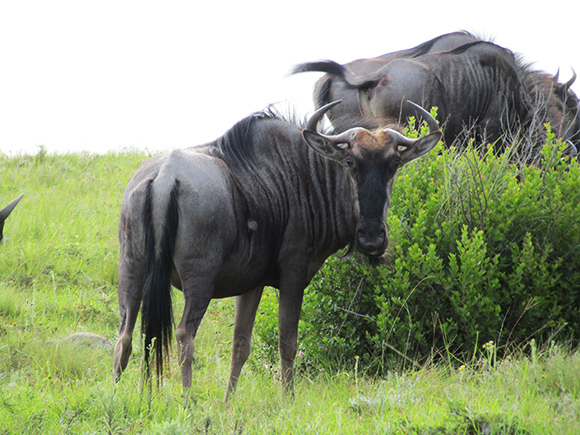
Female Blue Wildebeest 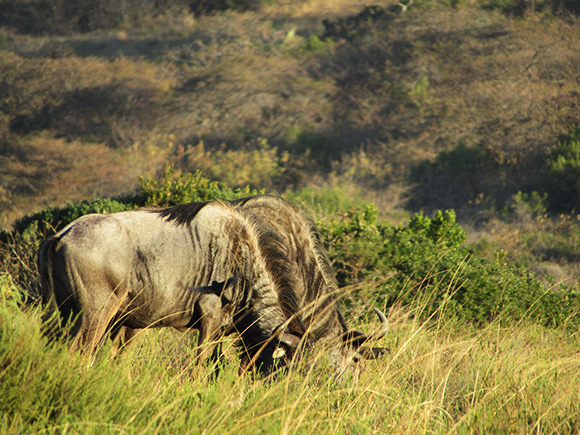
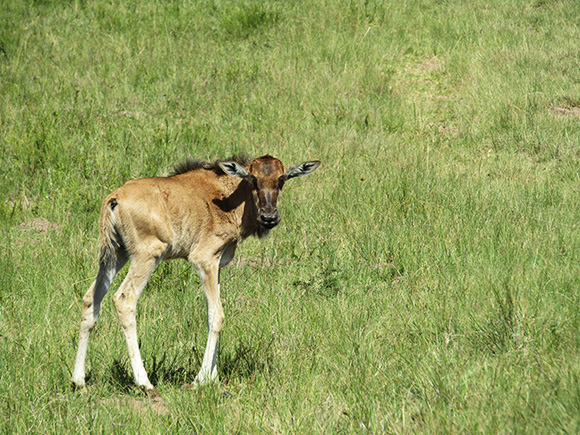
Blue Wildebeest Calf 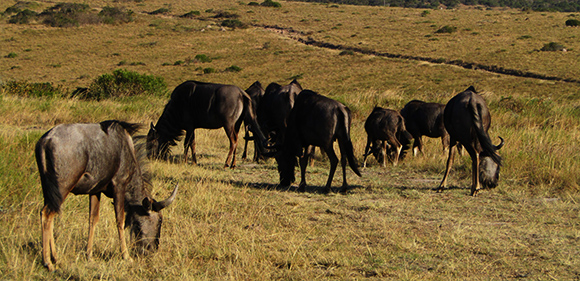
Prefer feeding on short grass.
Waterbuck (Kobus ellipsiprymnus) are most definitely a gorgeous antelope species, with beautiful shaggy, grey fur and a perfect heart-shaped nose. The males have stunning, long horns that curve forwards, and both male and female have a distinctive white ring that circles their hindquarters (it looks almost like a bulls-eye target). This white ring serves as a ‘follow me’ sign for the waterbuck to easily follow one another whilst evading predators. They have an average shoulder height of up to 1.7 meters and a weight of up to 270kg making them one of the larger species of antelope that you will find out in the African bush.
Waterbuck are a well adapted antelope. Getting their name from the fact that you will never find them too far from a large water source as, being strong swimmers they will run straight into deep water to evade predators.
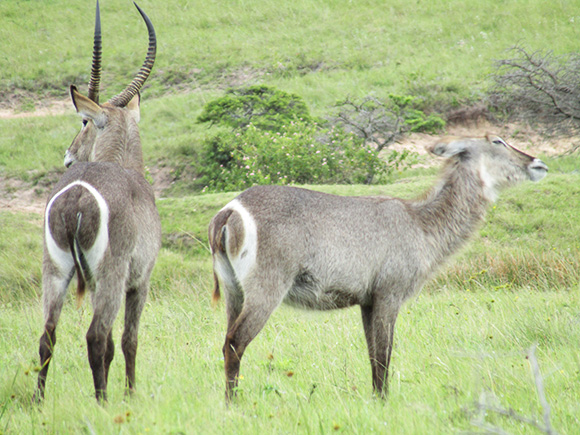
White ring on hindquarters 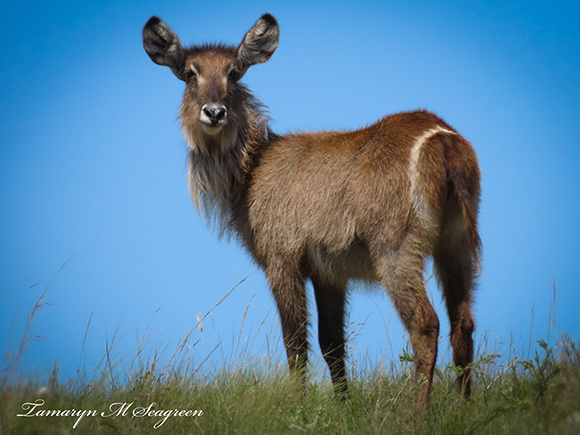
Shaggy grey coat 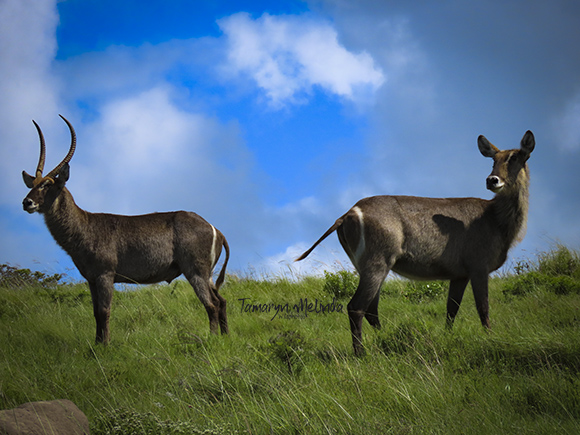
Male and female Waterbuck
You may have noticed that a Waterbuck has a lot of long shaggy fur around their neck, interestingly the hair follicles of that hair is hollow, giving the Waterbuck more buoyancy while swimming or wading through deep water. They have oil glands in the crease of their hind legs that secretes foul-smelling oil through their fur which repels water. As they walk out of the water, the water drips off the outer fur leaving their inner fur bone dry.
There has been a lot of debate on the actual purpose of the foul-smelling aspect of the oil that the Waterbuck secrete into their fur. One of the most common theories is that the bad smell deters predators, mostly crocodiles as they run and swim through rivers and dams, however, unfortunately there is a lot of photographic evidence to disprove this theory. The latest accepted theory is that the bad smell acts as an insect repellent, predominantly lessening the number of ticks found on the Waterbuck.
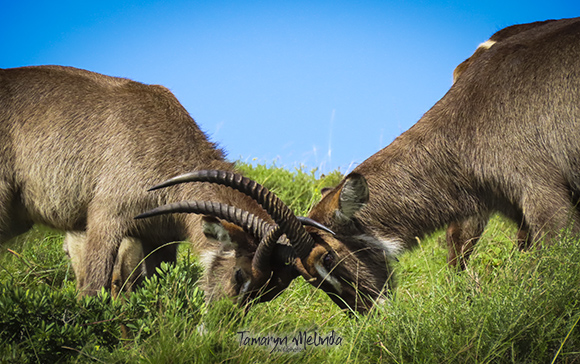
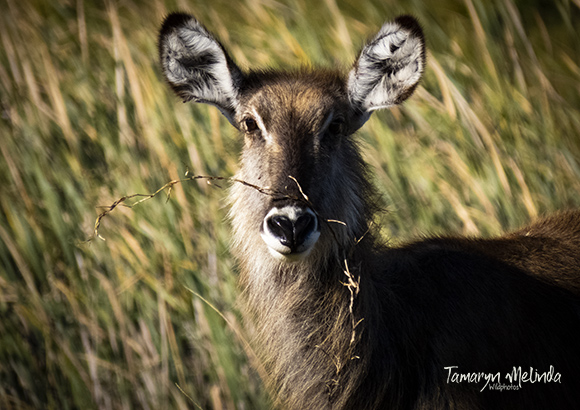
Hollow hair follicles around neck 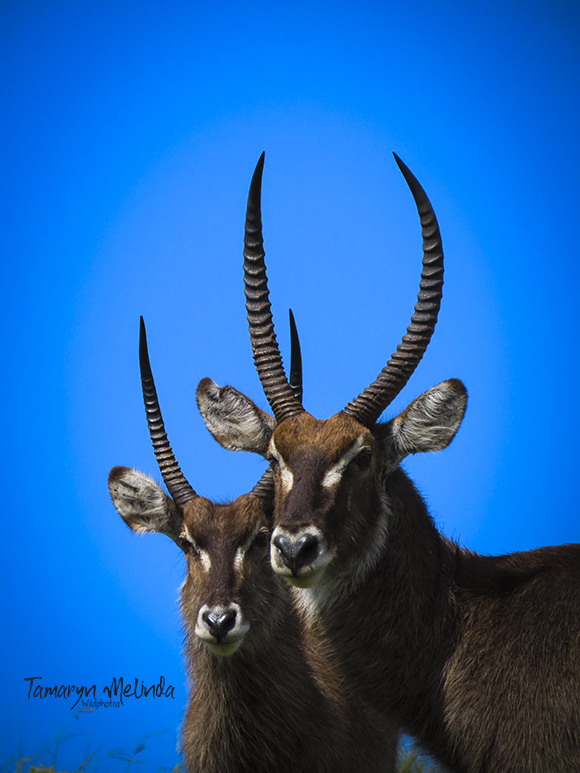
Male Waterbuck
Red Hartebeest (Alcelaphus buselaphus) have been said to get their name from the heart-shaped way their horns curve, however, their name originates from the Dutch word ‘Hert’, which means ‘Deer’ in Dutch and ‘Beest’, meaning ‘Beast’, forming the name ‘Hertebeest’ used by the early Dutch settlers, now known as a ‘Hartebeest’ in Afrikaans.
I always appreciate sightings of these beautiful animals as they are strong runners – sprinting off at speed of up to 55km/h whenever they sense that danger may be near. These large antelope have a shoulder height of up to 1.3 meters and an average weight of up to 150kg.
Like Impala, the Red Hartebeest are mixed feeders, feeding selectively on grass as well as certain trees and shrubs in the area.
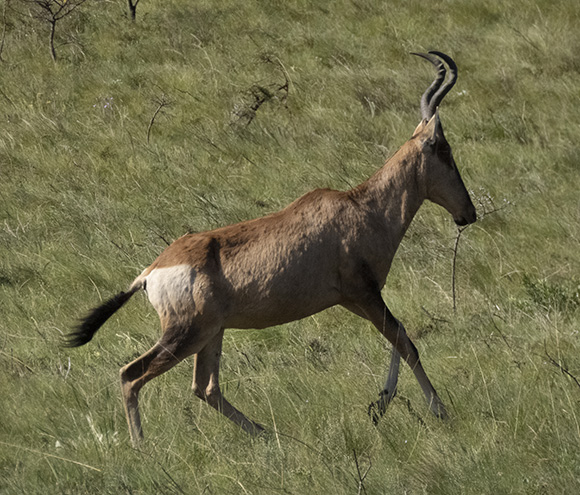
Running up to 55km/h 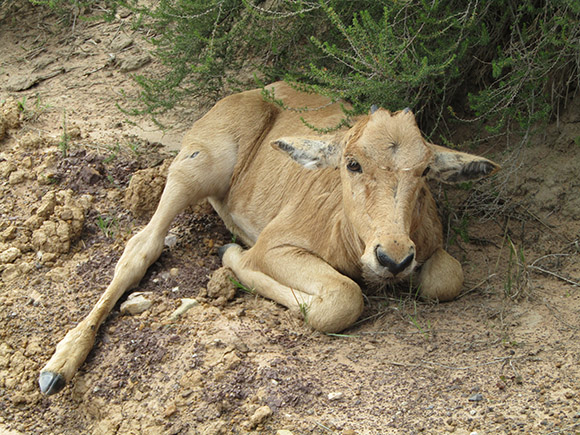
Red Hartebeest Calf 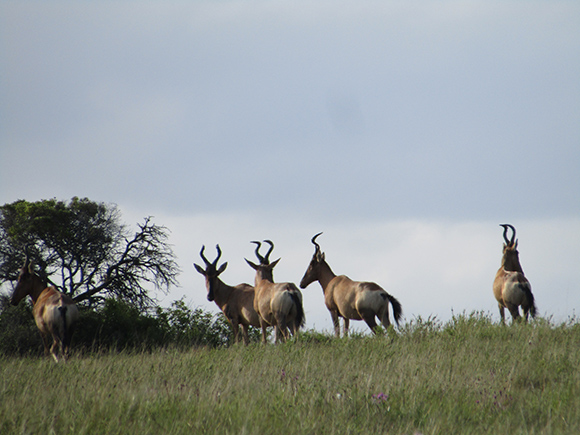
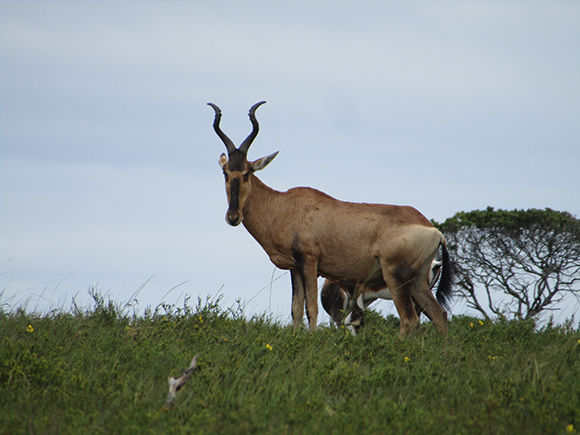
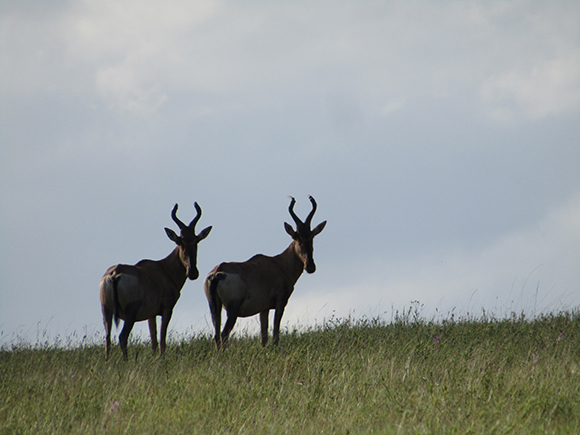
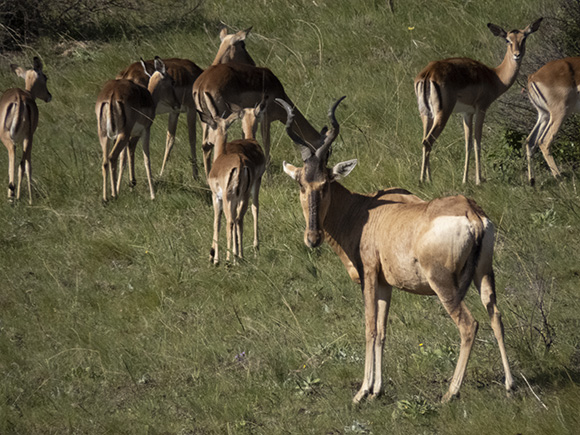
Impala (Aepyceros melampus) are one of the most beautifully, well-groomed antelope that you will ever see out in the African bush. Their fur is almost always smooth and shiny, and it’s rare to see ticks on their beautiful coats. This is because Impala are one of the only species of antelope that perform what we call ‘Allo-grooming’ (grooming one another). Impala have an incredibly complex social system, which makes them very well adapted to their environment.
During lambing season (December time), Impala females form ‘Nursing herds’. These nursing herds are comprised of all the lambs in the herd grouping together with one or two females keeping an eye on them, the females take turns in watching the young lambs, taking turns to go and feed. This is one of many interesting social behaviours that they have.
Impala are notably smaller than the other antelope species that I’ve spoken about already, with an average shoulder height of 90 centimetres and an average weight of 50kg.
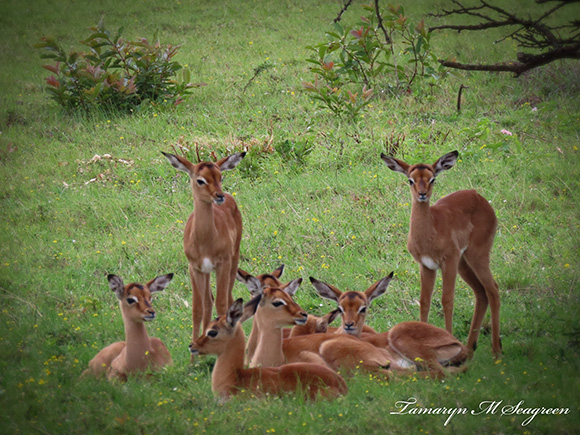
Nursing Herd 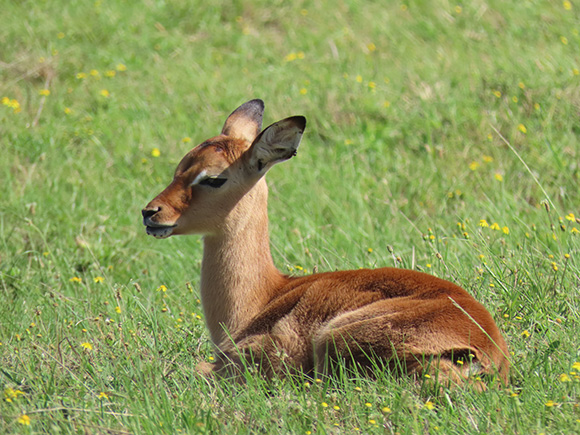
Impala Lamb 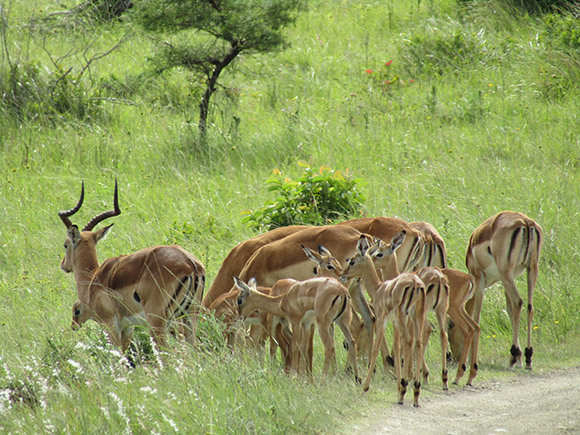
Breeding Herd 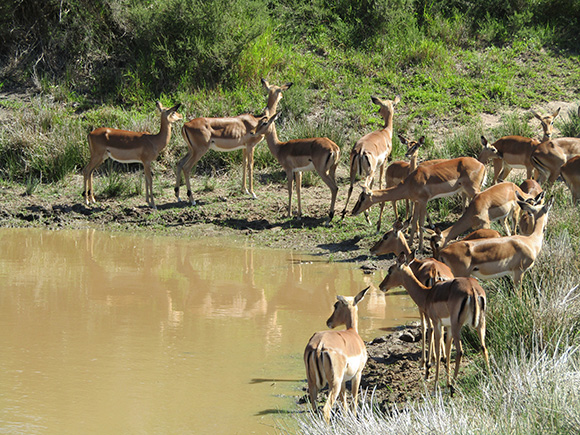
Impala at a Waterhole 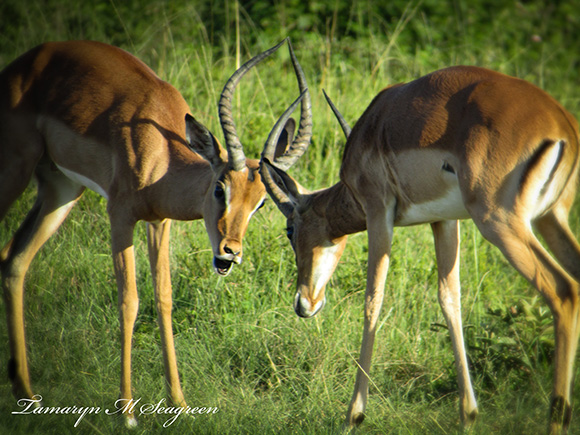
Young Impala males fighting for dominance.
Another common antelope that you will see huddled together on the open plains is a Blesbok (Damaliscus pygargus phillipsi), these lovely dark antelope have an unmistakable white face, easily confused with a Bontebok which occurs in the fynbos areas of the Western Cape. The most notable difference between the two is that the white on the Blesbok’s face is broken by a brown horizontal strip whereas the white on the Bonteboks face is solid (they also have more white on their rump and belly than a Blesbok). Similar in size to an Impala the Blesbok have an average shoulder height of 95 centimetres and a weight of 60-70kg.
I have been fortunate enough to photograph a rare white colour variation of a Blesbok, this is caused by a rare genetic mutation called Leucism. You can read more about Leucism in one of my previous blogs about White Lions.
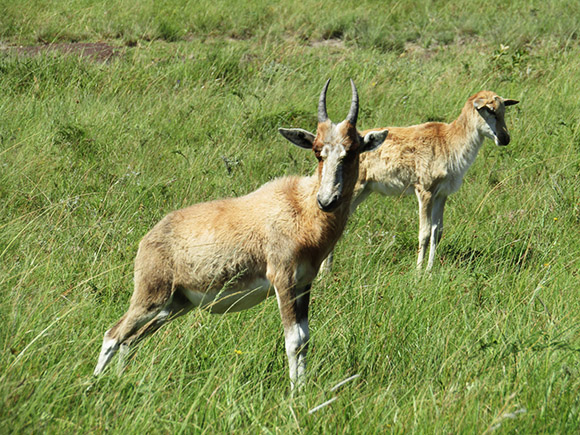
Young Blesbok 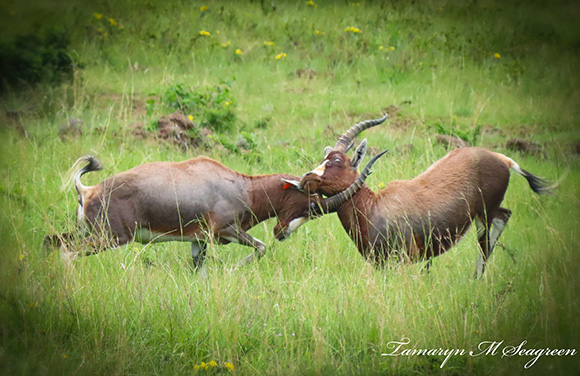
Blesbok males fighting for dominance 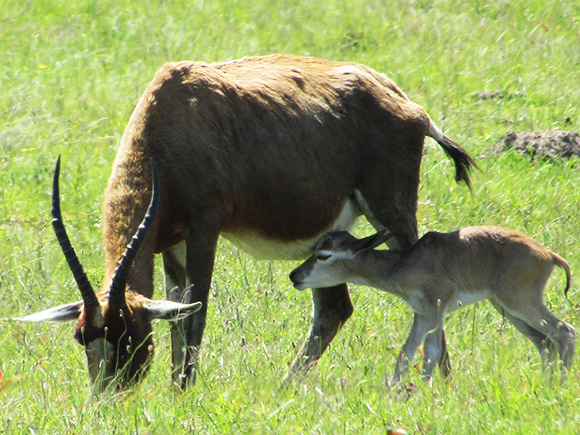
Blesbok mother and lamb 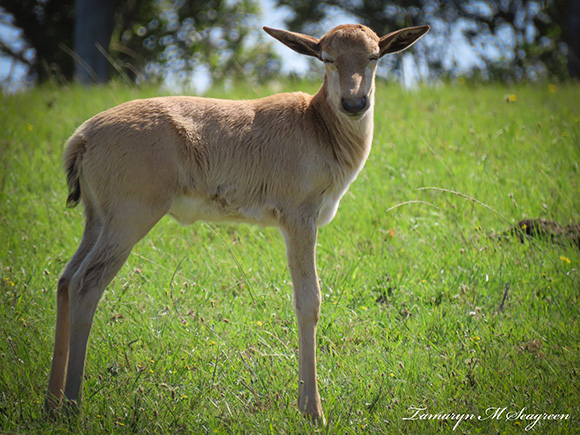
Blesbok Lamb 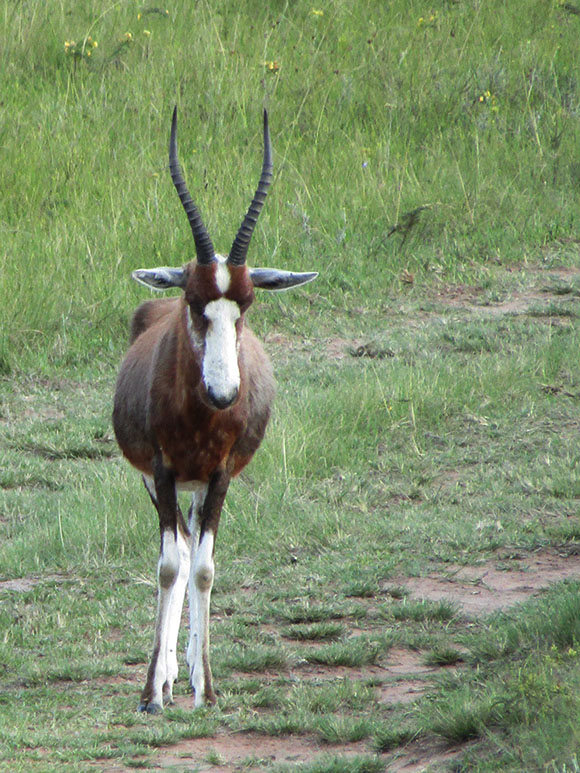
Note the break in white on the face
Mountain Reedbuck (Redunca fulvorufula) are a rare sight to see on the reserve as these stunning, grey antelope are extraordinarily good at hiding themselves. Being mostly solitary animals, it makes it that much more difficult to spot them, however, sometimes when resources are abundant, you may find them in small groups.
They are also monogamous meaning they bond with a mate for life, and it’s easy to tell the males and females apart as the males have small, forward curving horns, whereas the females do not. They have an average shoulder height of 70cm and weight of only 30kg.
As their name suggests, a Mountain Reedbuck is usually found on slopes and mountainous areas.
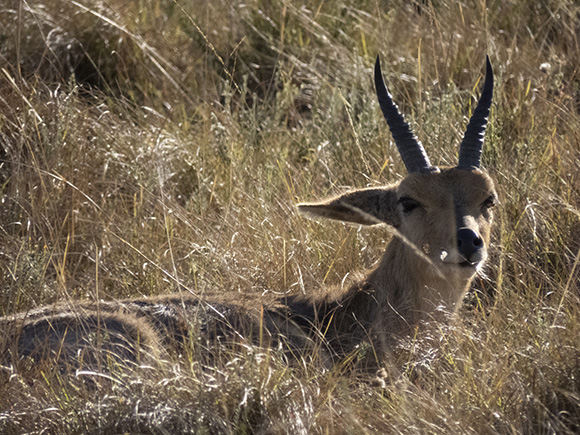
Male Mountain Reedbuck Hiding 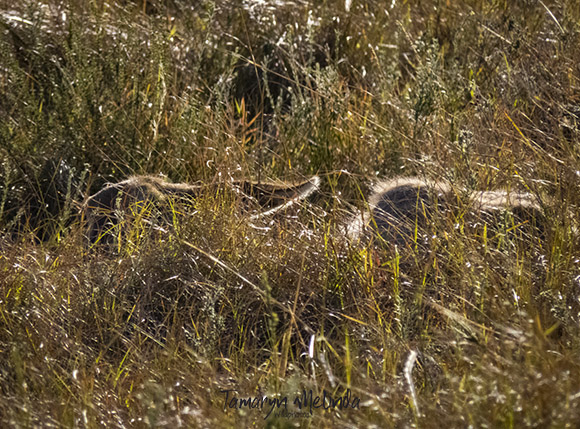
You can’t see me! 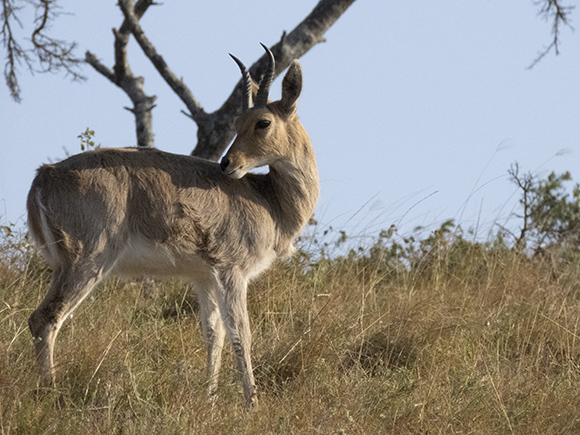
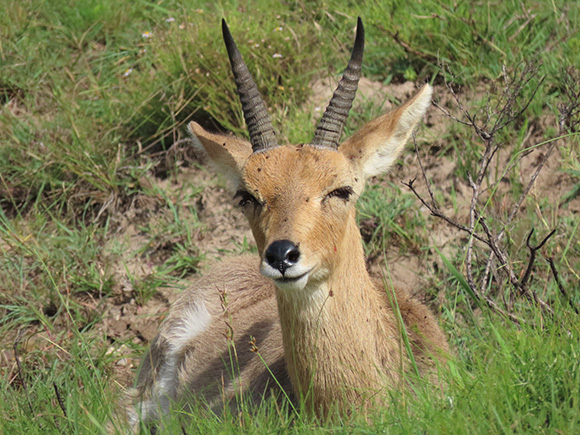
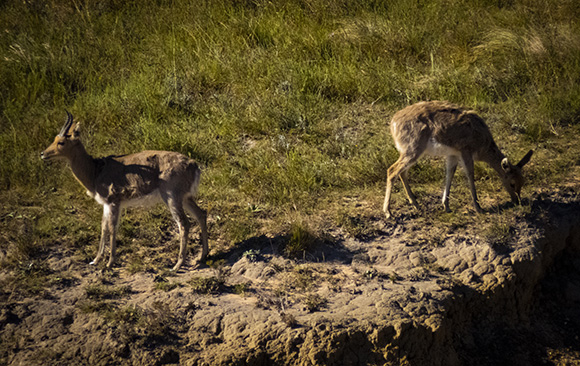
Male and Female Mountain Reedbuck
The smallest species of antelope in Southern Africa is a Blue Duiker (Philantomba monticola), with an average weight of only 4kg and a shoulder height of a mere 30 centimetres, these adorable antelope are an exciting sight to see. Being forest dwelling and solitary, it’s incredibly rare to have sightings of them as they have an average territory size of up to 1 hectare.
One of the duiker species that is also rare to see, but is slightly more common, is a Common / Grey Duiker (Sylvicapra grimmia). I have managed to get only one photograph of this beautiful little antelope as they are extraordinarily quick on their feet and usually disappear into the bushes before you have time to pick up your camera. They are slightly bigger than the Blue Duiker with an average shoulder height of up to 51 centimetres and weight of up to 20kg.
When it comes to Duiker species, both males and females have horns, with the exception of a Common / Grey Duiker where the female does not have horns. Duiker are nocturnal animals, only being active at night and sometimes at dawn and dusk. All species of Duiker, like the Mountain Reedbuck, are monogamous, bonding with one mate for life.
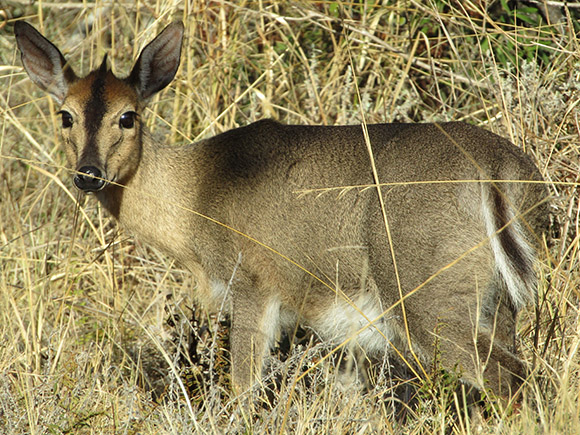
Common / Grey Duiker 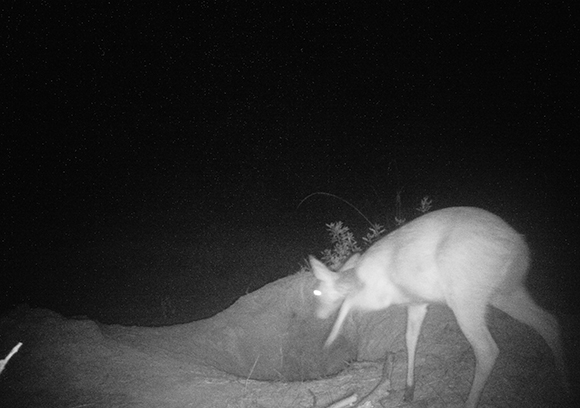
Duiker photographed by one of the Trail Cameras
Thank you for reading another one of my blogs! I look forward to sharing another with you all soon.
Please feel free to ask any questions you may have in the comments section below and if any of you would like me to cover a specific subject in a future blog, please comment with your subject suggestions or requests.
Remember to stay safe.
Warm regards,
Ranger Tammy




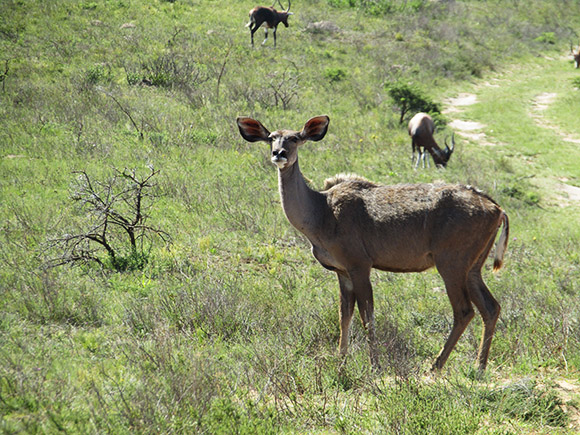
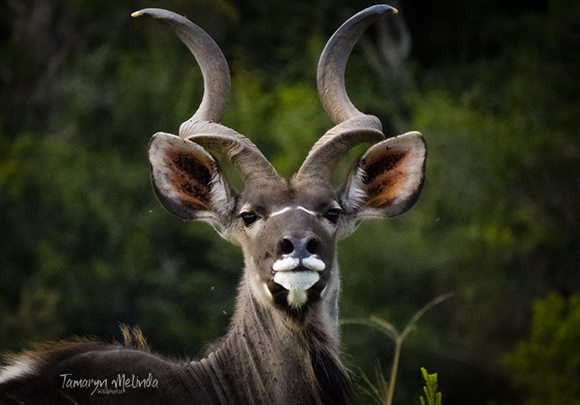
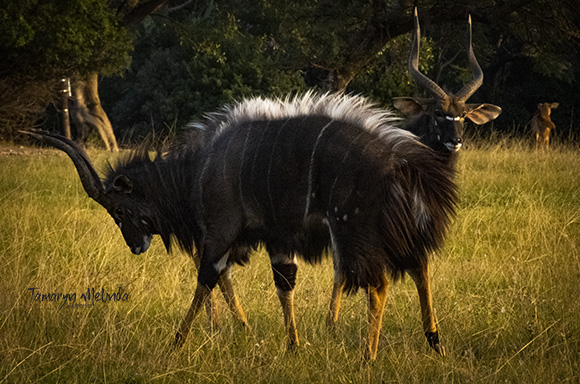
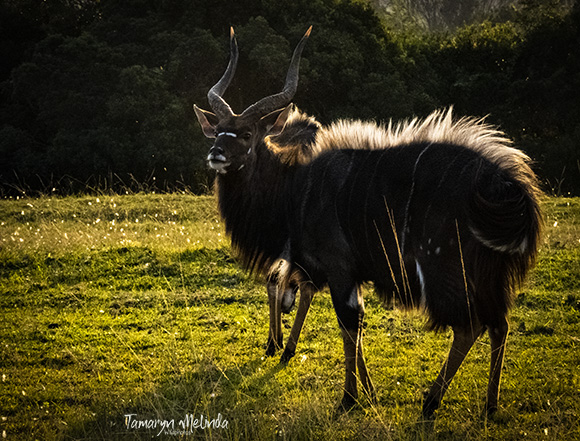
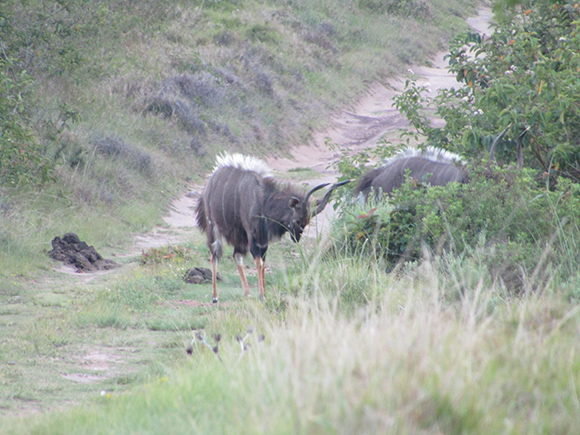
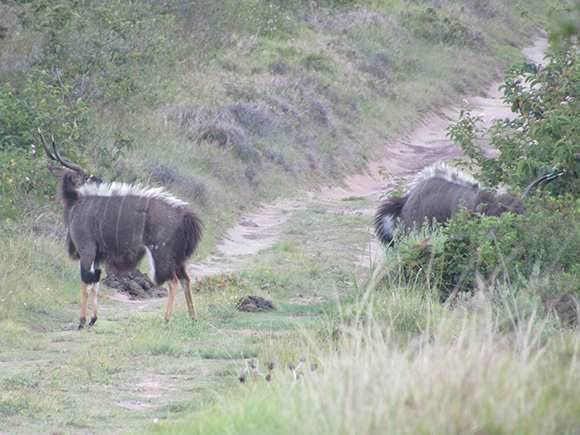
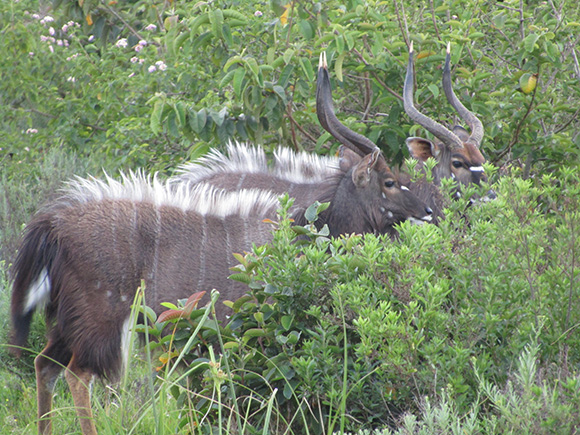
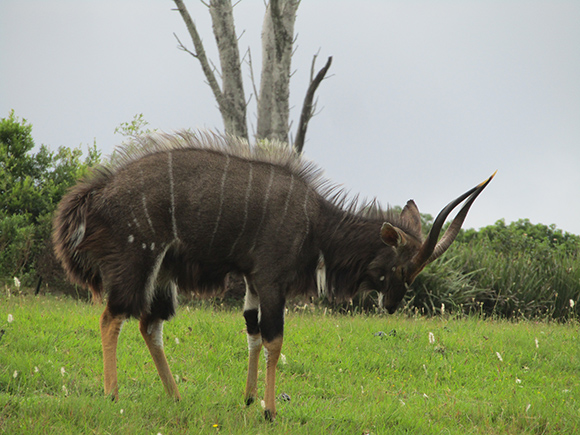
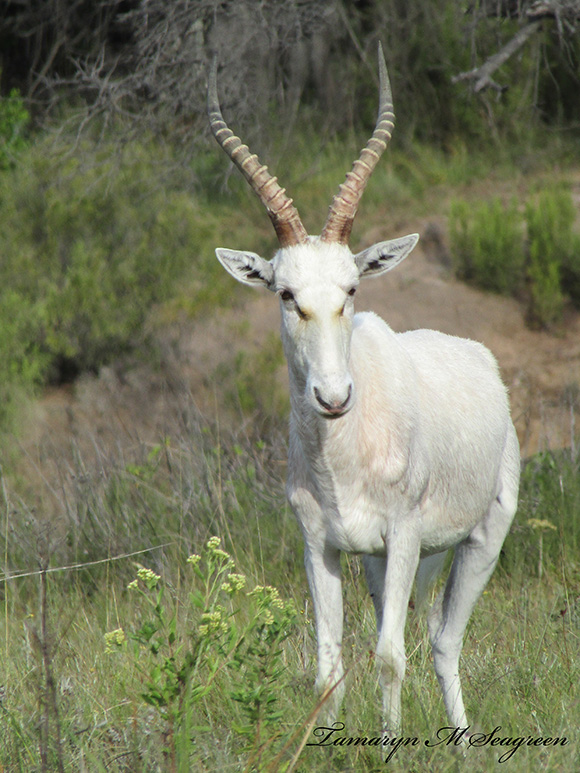
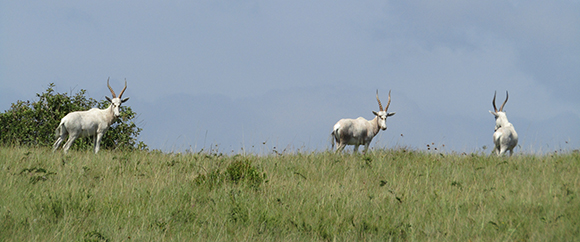

Excellent Tams and very informative.
Fascinating animal and a real challenge to a veterinarian to anaesthetise. Collapse of the valves stops supply of blood to the brain and death. Once down the animal has to be given the reversal drug in few minutes to prevent the cardio respiratory collapse. Enjoy the lovely rain regards
Excellent and informative
You must have had a spectacular view of all those animals after the rain…I will have to find someone to take me there when in East London. Enjoyed reading your post.
Great pics Tammy.
Will be there soon.
Regards
Gabriel
Another informative and excellent blog.
I just want to mention I am just all new to blogs and certainly loved your page. Almost certainly I’m likely to bookmark your blog . You surely come with wonderful posts. Thanks a lot for sharing your web-site.
I simply want to say I am beginner to blogging and site-building and seriously loved you’re web site. Very likely I’m likely to bookmark your blog . You absolutely come with tremendous articles and reviews. Appreciate it for revealing your webpage.
I simply want to mention I am very new to blogging and seriously liked your web blog. Almost certainly I’m want to bookmark your site . You surely have terrific article content. Regards for revealing your web page.
I just want to mention I am just beginner to blogging and site-building and really savored this website. Probably I’m going to bookmark your website . You surely have very good articles. Thank you for revealing your web page.
I truly appreciate this post. I have been looking all over for this! Thank goodness I found it on Bing. You have made my day! Thank you again!
It’s truly a nice and helpful piece of info. I am satisfied that you just shared this useful information with us. Please keep us up to date like this. Thank you for sharing.
wonderful post, very informative. I wonder why the other specialists of this sector don’t notice this. You must continue your writing. I’m sure, you’ve a great readers’ base already!
Thank you so much for providing individuals with a very remarkable possiblity to read articles and blog posts from this site. It’s usually so lovely and also stuffed with amusement for me and my office mates to visit your blog on the least thrice in one week to study the new secrets you have got. And definitely, I’m just certainly astounded considering the magnificent tactics served by you. Selected 3 points in this posting are absolutely the most suitable I’ve ever had.
I’d should check with you here. Which isn’t one thing I often do! I get pleasure from studying a submit that may make folks think. Additionally, thanks for allowing me to comment!
It’s not my first time to go to see this web page, i am visiting this web site
vrry often and take good facts from here.
Well I certainly liked learning this. This topic acquired through you is extremely efficient for accurate planning.
You are so cool man, the post on your blogs are super great.~~.’”
I am delighted that I detected this weblog, just the right information that I was looking for!
Hey! I loved your article. Keep writing stuff like this. I’ll return to see more articles like this. It was very creative. TTYL!
I am glad to be a visitor of this gross weblog, appreciate it for this rare info!
I like it whenever people come together and share thoughts.Great website, continue the good work!|
I conceive this web site contains some rattling fantastic info for everyone : D.
This website is really a walk-through you discover the details it suited you in regards to this and didn’t know who must. Glimpse here, and you’ll absolutely discover it.
Usually I don’t read post on blogs, but I wish to say that this write-up very forced me to try and do so! Your writing style has been surprised me. Thanks, very nice post.
Solid post! I actually wasn’t aware of this. It’s refreshing to read because I get so annoyed when writers put no thought into their work. It’s obvious that you know what you’re writing about. I shall definitely visit again!
Really Interested site this is.. I really Enjoy a lot reading your Blog.. I will Bookmark your site for more remark.
Have you considered about including some social bookmarking buttons to these blogs. At least for twitter.
Fantastic article! I’ll be back to see your next article! Thank you!
You made some nice points there. I looked on the internet for the subject matter and found most individuals will agree with your site.
Hello! I could have sworn I’ve been to this blog before but after browsing through some of the post I realized it’s new to me. Anyways, I’m definitely happy I found it and I’ll be book-marking and checking back frequently!
This is really fascinating, You are a very professional blogger. I’ve joined your rss feed and sit up for searching for more of your great post. Also, I have shared your site in my social networks!Cleora Pilling
You seem to be very professional in the way you write.::’~*Estella Matchett
I really enjoyed this blog post. You are an excellent writer. I’ll be back to see more! Thanks so much!
This site is great. I’ll return soon to see more. Thanks so much! Have a great day!
I’am amazed